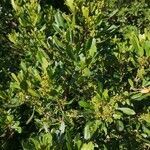Quite glabrous; leaves petiolate; leaflets sessile, lanceolate-obtuse, mucronulate, with revolute, remotely denticulate margins, paler beneath, parallel-veined on both sides; panicles axillary and terminal, longer than the leaves, with slender branches and capillary pedicels. A shrub, with terete, greyish branches; flowering branchlets short. Petioles subterete, furrowed above, 0.5-1 inch long. Leaflets 2-2.5 inches long, 4-6 lines wide, particularly in the upper part denticulate, a few narrowed at base, the lateral ones mostly half as long. Lateral panicles about 3 inches long, ultimate pedicels 1/2 line long. Flowers very minute. Differs from R. viminalis and lancea by the obtuse, denticulate leaves and longer panicles.
A shrub or small tree. It can be up to 6 m tall. It may have many stems and the bark is cracked. The branches are slender and often arch over. It may or may not have spines. The spines can vary. The leaves also vary. They usually have 3 leaflets which are oval. The central leaflet is long. It can be 7 cm long with a bluntly pointed tip. The edges of the leaves normally have teeth. The leaves are paler underneath. The midrib can normally be easily seen on both surfaces. The leaf stalks are usually red and slender. The flowers are small and yellow. The flowers are in loose heads both at the ends of branches and in the axils of leaves. The fruit are round but often slightly lopsided. They are brown. The fruit are edible.
Tree or shrub, 1-7 m high; spreading; bark rough, granular, grey-brown; branchlets whitish grey, lenticels prominent, often terete, stout spines. Leaves petiolate, trifoliolate; leaflets sessile, membranous to submembranous, glaucescent to shiny dark green above, slightly paler below, glabrous, lanceolate to narrowly elliptic, margins entire or crenulate to crispate in upper half, often undulate. Inflorescence much-branched panicle, lax, axillary and terminal, exposed, up to 80 mm long, furfuraceous. Flowers small, greenish yellow. Fruit a drupe, circular-oblate, ellipsoid, glabrous, shiny, light to cinnamon-brown.
Spinous open shrub or small crooked-stemmed tree, up to 8 m high. Old bark fissured to blocky. Leaflet margin entire or crenulate to crispate in upper half, often undulate. Drupes smooth, oblate, ellipsoid. Flowers cream.
Spinous open shrub or small crooked-stemmed tree, up to 8 m high. Old bark fissured to blocky. Leaflet margin entire or crenulate to crispate in upper half, often undulate. Drupes smooth, oblate, ellipsoid. Flowers cream.


